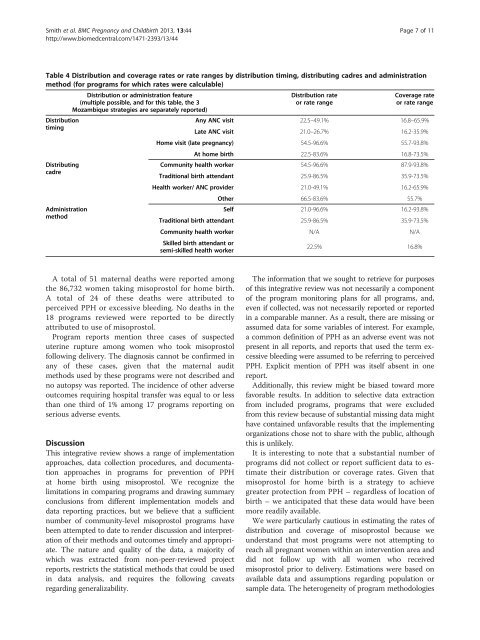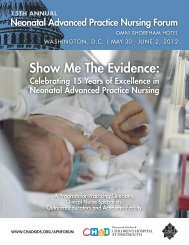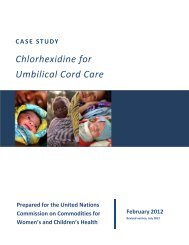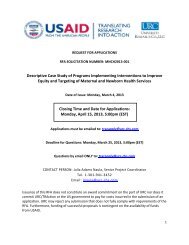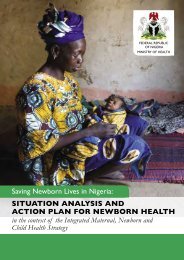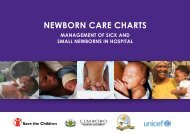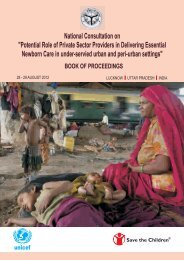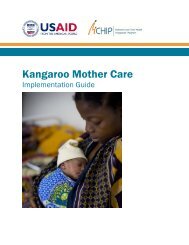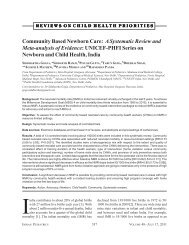Smith et al. BMC Pregnancy and Childbirth 2013, 13:44 Page 6 of 11http://www.biomedcentral.com/1471-2393/13/44document the clinical effect of misoprostol on PPH<strong>prevention</strong>, but, rather, to document the operationaland health-related outcomes of the program’s chosenimplementation methods.All but one of the programs included in this revieweither explicitly mentioned using a dose of 600 μgmisoprostol, which is commonly manufactured as threetablets of 200 μg each, or mentioned using “threetablets” and there<strong>for</strong>e presumably used a dose of600 μg, the WHO currently recommended dosage [46].Oneprogramusedadoseof400μg only[14].Thirteen of the 18 programs described their user educationmethods in their reports. The programs used avariety of strategies to provide in<strong>for</strong>mation, educationand communication to women and their families aboutthe purpose and proper use of misoprostol, includingindividual meetings, group meetings, print media, andradio messages. Most programs emphasized the importanceof delivering in a health facility as one of the keymessages.Nine programs described in<strong>for</strong>mation on stock-outsand methods used to avoid them. All 18 specified thenumber of doses distributed. Accounting methodsincluded periodic meetings among program staff (n = 8;44.4%), stock monitoring by hand count (n = 6; 33.3%),and accounting <strong>for</strong> the voluntary return of unused drugs(n = 3; 16.7%).Tables 3 and 4 depict the various times chosen byprograms to distribute misoprostol to women, the cadresused to distribute the drug, and the individual(s) whoadministered the drug. Four of 18 programs (22.2%)distributed the drug earlier than 28 weeks of pregnancy.Nine programs distributed misoprostol at the time ofhome birth, two of which included the medication inclean delivery kits (CDKs) [45].Health workers (including ANC providers) and TBAswere the most common distributors of the medication(7 programs each). Six programs used CHWs, and twoused “other” community health personnel, such as familyplanning field workers or community drug keepers, inthe distribution ef<strong>for</strong>t.Self-administration (n = 11; 61.1%) and administrationby TBAs (n = 8; 44.4%) were the two most commonmethods used <strong>for</strong> administration of the drug (Table 3).Additional methods included administration by CHWsand skilled or semi-skilled birth attendants.Tables 4 and 5 illustrate the wide variation in the distributionand coverage rates achieved among the 11programs <strong>for</strong> which sufficient in<strong>for</strong>mation was available.Seven programs did not report sufficient in<strong>for</strong>mation toreliably calculate either of these rates. One program inMozambique used three different distribution strategies,resulting in similar distribution rates regardless of whetherTBAs, ANC providers, or both, were the distributingTable 3 Types of misoprostol distribution andadministrationDistribution and administrationfeature (multiple possible)Distribution timingN of programs(total = 18)%ofprogramsAny ANC visit (>12 weeks) 4 22.2Late pregnancy ANC visit (>28 weeks) 3 16.7Late pregnancy home visit5 27.8(28–32 weeks)At home birth 9 50.0Distributing cadreCHW 1 6 33.3TBA 7 3 38.9Health workers 2 /ANC providers 7 38.9Other (family planning field worker, 2 11.1community drug keeper)Administration methodSelf 11 61.1TBA 8 44.4CHW 1 5.6SBA 4 2 16.71 Includes female community health volunteers in Nepal and communitybasedlady health workers in Population Council’s Pakistan program.2 Includes auxiliary nurse midwives in India.3 One program with 99.6% CHW distribution and only 0.4% TBA distributionwas considered to be CHW distribution only.4 This category also includes two types of semi-skilled health workers: auxiliarynurse midwives in India and community midwives in Kenya.cadre(s) (range of 21.0% to 26.7%); however, markedlyhigher coverage rates were achieved with TBAs as the distributingcadre (73.5% compared to 16.2% <strong>for</strong> ANC only).The unexpected similarity in distribution rates might beexplained by the fact that only a sub-sample of womenwith follow-up data was included in the calculations fromANC distribution sites, while the entire sample wasincluded in the calculations from TBA distribution sites.Three programs attempted to assess whether therewas any change in the facility birth rate in the districtsin which misoprostol was distributed <strong>for</strong> home use. InAfghanistan [24] and Zambia [43] comparison betweenthe intervention and control areas showed an increase of3.3% and 13.8%, respectively, in facility birth rates in theintervention areas. In Nepal [23] there was an increaseof 3.9% in the facility birth rates at the end of the intervention,when compared to the beginning.Table 6 presents the occurrence of adverse outcomeswhen misoprostol was used <strong>for</strong> <strong>prevention</strong> of PPH athome birth. Incorrect use of the drug (consumptionbe<strong>for</strong>e the birth) occurred in seven cases across fourprograms, among 12,615 users, <strong>for</strong> an overall rate of0.06%. Many of the programs also reported instanceswhen the drug was incorrectly administered after deliveryof the placenta or if fewer than the required numberof tablets had been taken.
Smith et al. BMC Pregnancy and Childbirth 2013, 13:44 Page 7 of 11http://www.biomedcentral.com/1471-2393/13/44Table 4 Distribution and coverage rates or rate ranges by distribution timing, distributing cadres and administrationmethod (<strong>for</strong> programs <strong>for</strong> which rates were calculable)Distribution or administration feature(multiple possible, and <strong>for</strong> this table, the 3Mozambique strategies are separately reported)DistributiontimingDistributingcadreAdministrationmethodDistribution rateor rate rangeCoverage rateor rate rangeAny ANC visit 22.5–49.1% 16.8–65.9%Late ANC visit 21.0–26.7% 16.2-35.9%Home visit (late pregnancy) 54.5-96.6% 55.7-93.8%At home birth 22.5-83.6% 16.8-73.5%Community health worker 54.5-96.6% 87.9-93.8%Traditional birth attendant 25.9-86.5% 35.9-73.5%Health worker/ ANC provider 21.0-49.1% 16.2-65.9%Other 66.5-83.6% 55.7%Self 21.0-96.6% 16.2-93.8%Traditional birth attendant 25.9-86.5% 35.9-73.5%Community health worker N/A N/ASkilled birth attendant orsemi-skilled health worker22.5% 16.8%A total of 51 maternal deaths were reported amongthe 86,732 women taking misoprostol <strong>for</strong> home birth.A total of 24 of these deaths were attributed toperceived PPH or excessive bleeding. No deaths in the18 programs reviewed were reported to be directlyattributed to use of misoprostol.Program reports mention three cases of suspecteduterine rupture among women who took misoprostolfollowing delivery. The diagnosis cannot be confirmed inany of these cases, given that the maternal auditmethods used by these programs were not described andno autopsy was reported. The incidence of other adverseoutcomes requiring hospital transfer was equal to or lessthan one third of 1% among 17 programs reporting onserious adverse events.DiscussionThis integrative review shows a range of implementationapproaches, data collection procedures, and documentationapproaches in programs <strong>for</strong> <strong>prevention</strong> of PPHat home birth using misoprostol. We recognize thelimitations in comparing programs and drawing summaryconclusions from different implementation models anddata reporting practices, but we believe that a sufficientnumber of community-level misoprostol programs havebeen attempted to date to render discussion and interpretationof their methods and outcomes timely and appropriate.The nature and quality of the data, a majority ofwhich was extracted from non-peer-reviewed projectreports, restricts the statistical methods that could be usedin data analysis, and requires the following caveatsregarding generalizability.The in<strong>for</strong>mation that we sought to retrieve <strong>for</strong> purposesof this integrative review was not necessarily a componentof the program monitoring plans <strong>for</strong> all programs, and,even if collected, was not necessarily reported or reportedin a comparable manner. As a result, there are missing orassumed data <strong>for</strong> some variables of interest. For example,a common definition of PPH as an adverse event was notpresent in all reports, and reports that used the term excessivebleeding were assumed to be referring to perceivedPPH. Explicit mention of PPH was itself absent in onereport.Additionally, this review might be biased toward morefavorable results. In addition to selective data extractionfrom included programs, programs that were excludedfrom this review because of substantial missing data mighthave contained unfavorable results that the implementingorganizations chose not to share with the public, althoughthis is unlikely.It is interesting to note that a substantial number ofprograms did not collect or report sufficient data to estimatetheir distribution or coverage rates. Given thatmisoprostol <strong>for</strong> home birth is a strategy to achievegreater protection from PPH – regardless of location ofbirth – we anticipated that these data would have beenmore readily available.We were particularly cautious in estimating the rates ofdistribution and coverage of misoprostol because weunderstand that most programs were not attempting toreach all pregnant women within an intervention area anddid not follow up with all women who receivedmisoprostol prior to delivery. Estimations were based onavailable data and assumptions regarding population orsample data. The heterogeneity of program methodologies


